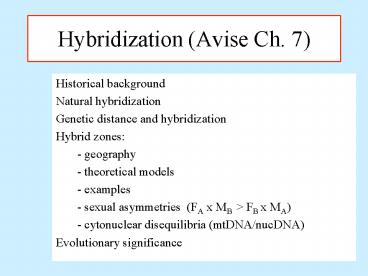Hybridization Avise Ch. 7 - PowerPoint PPT Presentation
1 / 31
Title:
Hybridization Avise Ch. 7
Description:
'The time to divergence for sister species is shorter at high latitudes and ... ( Reticulate evolution) *allopolyploids. Sunflower. Reticulate evolution ... – PowerPoint PPT presentation
Number of Views:292
Avg rating:3.0/5.0
Title: Hybridization Avise Ch. 7
1
Hybridization (Avise Ch. 7)
- Historical background
- Natural hybridization
- Genetic distance and hybridization
- Hybrid zones
- - geography
- - theoretical models
- - examples
- - sexual asymmetries (FA x MB gt FB x MA)
- - cytonuclear disequilibria (mtDNA/nucDNA)
- Evolutionary significance
2
Speciation and Hybridization
- The time to divergence for sister species is
shorter at high latitudes and longer in the
tropics.
3
Mussel Bimodal Hybrid Zone - Prezygotic
- Postzygotic
F1
4
Bimodal Hybrid Zones
- Reading for Wed. March 21
- Bimodal hybrid zones and speciation
- Chris D. Jiggins and James Mallet
- http//www.mun.ca/biology/dinnes/B4250/Biol4250.ht
ml
5
Hybridization
- G. L. Stebbins (1950) Evolutionary role of
hybridization - the true situation, at least as far as the
higher plants are concerned, lies somewhere
between the extremes. - interspecific hybridization may not be as
uncommon in animals as is usually believed. - while hybridization is certainly less common in
animals than plants, and is correspondingly less
important as a factor in evolution, its influence
in certain groups may be considerable.
6
Speciation and Hybridization
http//www.nature.com/nature/journal/v446/n7133/fu
ll/nature05706.html
7
Hybridization in Plants
Higher frequency of hybridization in plants than
animals due to Sex
determination Mating system
variation (pollination)
Vegetative reproduction Ecotypes
(genetic-environment associations)
Polyploidy
8
Experimental Hybridization
Scarlet Gilia
9
Louisiana IrisesNatural Hybridization
10
Iris hexagona
Iris fulvia
Iris brevicaulis
Louisiana Irises
11
Genetic markers
- Nuclear RAPD, microsatellites,
- allozymes
- Cytoplasmic cpDNA
- Additional information
- Floral morphology, habitat
12
I. fulva I. brevicaulis
- absence of intermediate
- hybrids (F1)
- fulva ? forest
- brev. ? pasture
Nuclear and cpDNA
13
- Environmental Variables
- Elevation
- Light
- Veg. Comp.
14
Hybridization in Plants
Uncoupling of male and female components to gene
flow Pollen nuclear genes
Seed nuclear genes cpDNA
15
Iris Hybrid Zone
fulva hexagona
fulva hexagona
Nuclear Markers (pollen flow)
cpDNA (seed dispersal)
16
Hybrid Speciation in Plants
Hybrids between species if
fertile ? introgression if sterile ?
allopolyploid Reproductively isolated from parent
species
17
Hybrid Speciation (introgression)
F1
Time
18
Iris hexagona
Iris fulvia
Iris brevicaulis
Iris nelsonii
19
Hybrid Speciation in Irises(introgression)
Example Iris fulvia (Saltwater) Iris
hexagona (Freshwater) Iris brevicaulis (Pasture)
Iris nelsonii (Swamp, Ecotone)
20
Hybrid populations Iris nelsonii
Lack of foreign markers in I. nelsonii (genetic
stability) (Homoploid not polyploid)
21
Hybrid Speciation in Plants
Example Clarkia spp. (Reticulate
evolution)
22
allopolyploids
23
(No Transcript)
24
Sunflower Reticulate evolution
25
Evolutionary Significance of Hybridization
- Introgression source of genetic variation
for - adaptation
- Hybrid speciation
- Evolution of reproductive isolation
(speciation) - (reinforcement)
26
Evolutionary Significance of Hybridization
- Introgression source of genetic variation for
- adaptation
- Requires viable and reproductive hybrids for
gene flow between species
27
Evolutionary Significance of Hybridization
- Are natural hybrids fit or unfit relative to
their parents? Arnold and Hodges (1995) - - Viable and fertile F1 hybrids may be rare,
but repeated opportunities to form F1 - - wide range of hybrid fitness values
- lt , , gt parental taxa
- - importance of defining separate hybrid
classes to evaluate fitness (based on genetic
markers)
28
Hybrid Speciation
- The same sexual processes that formed the hybrid
can breakup the hybrid genotype - Stability of hybrid (limits to gene flow between
species) - - genetic incompatibility (gene, chromosome)
- - distinct ecological preference
- - polyploidy
- - agamospermy (asexual) asexual vertebrates
29
Speciation
- Bimodal hybrid zones and speciation
- Jiggins and Mallet (2000)
- Several genetic markers (multilocus)
- - classification of multiple hybrid
genotypes - Unimodal no assortative mating, hybrid swarm
- Bimodal strong assortative mating
- /- postzygotic incompatibilities
30
Bimodal Hybrid Zones
- Reading for Wed. March 21
- Bimodal hybrid zones and speciation
- Chris D. Jiggins and James Mallet
- http//www.mun.ca/biology/dinnes/B4250/Biol4250.ht
ml
31
Hybrid Zones
- Natural experiments
- - many generation of
hybridization and - recombination
- - areas of strong selection
- - ecological context
- - adaptive evolution
- - processes that cause divergent
evolution -
(speciation) - Windows on evolutionary process

